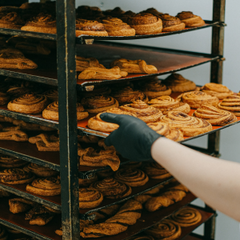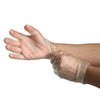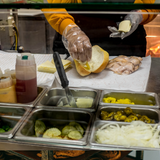Stepping into the world of food processing requires not only precision and expertise but also a keen eye on safety and hygiene. Among the essential tools of the trade, disposable gloves stand as a frontline defense, ensuring the integrity of the products and the well-being of those handling them. Navigating the diverse landscape of glove options can be a daunting task, and the right choice is pivotal for both compliance and performance. In this comprehensive guide, we embark on a journey through the considerations, types, and best practices in selecting disposable gloves tailored to the unique demands of food processing. From material choices to regulatory compliance, join us as we unravel the nuances of this crucial aspect, empowering professionals to make informed decisions that elevate safety standards in the dynamic realm of food processing jobs.
Food Processing Jobs

In the food industry, there are many different jobs and roles that need disposable gloves to uphold hygiene standards and ensure the safety of both consumers and workers. Bakeries rely on gloves to handle dough, ensuring a clean and contaminant-free baking process. In grocery stores, employees wear gloves during food preparation and handling, safeguarding against cross-contamination. Butchers utilize gloves to maintain a sanitary environment while cutting and packaging meat. Food manufacturing workers employ gloves across various stages of production, from ingredient handling to packaging. On farms and among farmers, gloves play a crucial role in handling produce, livestock, and agricultural chemicals. From chefs in restaurants to foodservice staff in catering, disposable gloves are indispensable in preserving the integrity of food products and upholding the highest standards of sanitation in the multifaceted landscape of the food processing industry.
How to Choose Food Processing Gloves
In food processing, where precision meets stringent hygiene standards, the choice of gloves is not just a matter of practicality but a crucial decision that impacts the safety and quality of the final product. As the frontline defense against contaminants and a vital tool in maintaining a clean and sanitary process, selecting the right gloves is incredibly important for professionals across diverse roles. From bakers crafting delicate pastries to butchers handling raw meat, the demands vary, and so do the considerations in glove selection. Join us in this exploration as we delve into the intricacies of choosing food processing gloves, navigating through material options, regulatory compliance, and industry-specific needs. This guide aims to empower individuals in the food processing realm to make informed choices, ensuring that their commitment to quality and safety is reflected in every aspect of their work.
Can You Use Latex Gloves in Food Processing?
No, you should try to avoid latex gloves when dealing with food. While latex gloves are known for their flexibility and comfort, they are generally not recommended in food processing environments due to the potential risk of latex allergies. The proteins present in latex can trigger allergic reactions in sensitive individuals, posing a significant concern for both workers and consumers. To safeguard against this risk, it is advisable to opt for alternative materials such as nitrile or vinyl gloves, which offer comparable dexterity without the associated latex allergy concerns. In fact, some states have even banned the use of latex gloves for food manufacturing. You can read more about that here in a previous blog post.
Materials You Can Use
-
Nitrile Gloves:

Description: Nitrile gloves are synthetic rubber gloves known for their excellent strength, durability, and resistance to chemicals. For tasks where you are coming into contact with chemicals we always recommend checking our chemical resistance chart to view specific chemical resistance levels.
Recommended Tasks: Ideal for tasks involving contact with chemicals, oils, and fats; suitable for food handling, preparation, and processing.
-
Vinyl Gloves:

Description: Vinyl gloves are made from PVC and are cost-effective, providing a comfortable fit and ease of use.
Recommended Tasks: Suitable for light-duty tasks, such as food handling, serving, and general kitchen duties; not recommended for tasks requiring high chemical resistance.
-
Poly Gloves:

Description: Polyethylene gloves are lightweight, economical, and offer a loose fit, providing a barrier against contaminants.
Recommended Tasks: Best suited for short-duration tasks where frequent glove changes are required, such as sandwich preparation, food assembly, and serving. Should never be used with chemicals.
-
Hybrid Gloves:

Description: Hybrid gloves are made for Low Density Polyethylene and offer a more durable and fitted option to poly while still being cost-effective.
Recommended Tasks: Versatile for various food processing tasks such as packaging baked goods, assembling sandwiches and prepping produce. Hybrid gloves should not be used with chemicals.
Durability and Puncture Resistance
The rigors of food preparation demand gloves that can withstand the challenges posed by sharp utensils, rough surfaces, and potential puncture hazards. Opting for gloves with high durability ensures longevity, reducing the need for frequent changes and minimizing the risk of contamination. Puncture-resistant gloves offer an additional layer of protection, guarding against accidental cuts or punctures during tasks. We typically recommend using Nitrile gloves for tasks where durability and puncture resistance are a high priority. For lower risk tasks like food prep and assembly you can go with more economical options like poly, hybrid or vinyl gloves which aren't considered to be as durable.
Comfort and Dexterity
The importance of comfort and dexterity in choosing gloves for food processing tasks lies at the intersection of efficiency, safety, and job satisfaction. In the fast-paced world of food processing, where intricate tasks demand precision, gloves that offer a comfortable fit and allow for dexterity play a pivotal role. Comfortable gloves enhance the overall user experience, promoting extended wear without compromising performance. The ability to maintain dexterity is equally crucial, especially in tasks requiring fine motor skills and intricate movements. Workers handling food in various capacities, from chefs in kitchens to assembly line operators, benefit from gloves that strike a balance between comfort and dexterity. If you're looking for comfortable and dexterous gloves we recommend selecting nitrile or vinyl - these types of gloves are more fitted than poly and hybrid which tend to be quite loose.
Frequency of Use

In food processing environments characterized by frequent glove changes and low-risk exposure, poly and hybrid gloves are the obvious choice. Polyethylene gloves, known for their lightweight and economical nature, are particularly well-suited for tasks where quick changes are necessary. Their loose fit allows for easy donning and doffing, making them ideal for short-duration tasks without sacrificing the necessary barrier against contaminants. Hybrid gloves, made from low density polyethylene, provide a balanced solution by offering enhanced durability compared to traditional poly gloves. This makes them an efficient choice for tasks with moderate risk levels, providing a cost-effective and resilient option that aligns with the specific demands of frequent glove changes in low-risk food processing environments such as prepping produce, packaging baked goods and making sandwiches..
Best Practices for Glove Usage in Food Processing
- Proper Glove Donning and Doffing: Ensure gloves are worn and removed following established protocols to prevent contamination.
- Regular Hand Washing: Hands should be washed before and after putting on gloves to maintain hygiene.
- Glove Selection Based on Task: Choose gloves appropriate for the specific food processing task, considering material, durability, and resistance.
- Frequent Glove Changes: Change gloves regularly, especially during transitions between tasks or when contamination is suspected.
- Avoiding Cross-Contamination: Use separate gloves for different tasks and designated gloves for handling raw and cooked food to prevent cross-contamination.
- Proper Storage: Store gloves in a clean and dry environment, avoid storing them in hot or damp places to maintain their integrity.
- Regular Inspection: Inspect gloves for any signs of damage, punctures, or tears before and during use to ensure effectiveness. Some types of gloves have expiration dates - so always double check the expiration when you open a new box.
- Training and Education: Provide comprehensive training on proper glove usage and hygiene practices for all food processing staff.
- Avoid Touching Face and Hair: Instruct workers to refrain from touching their face or hair while wearing gloves to minimize potential contamination.
- Compliance with Food Safety Regulations: Ensure that glove usage aligns with food safety regulations and standards relevant to the food processing industry.
- Glove Size Consideration: Select gloves that fit well to ensure comfort and prevent issues such as tearing or slipping during use. One size does not fit all.
- Immediate Glove Replacement: Replace gloves immediately if they become torn, punctured, or compromised in any way to maintain a high level of protection.
Regulations Compliance and Certification
In the realm of food processing, adherence to stringent regulations, compliance with industry standards, and obtaining relevant certifications are imperative aspects governing the use of gloves. We previously mentioned that latex gloves are banned for use in food manufacturing in many states but federal regulations apply as well. Various regulatory bodies, such as the Food and Drug Administration (FDA) in the United States or the European Food Safety Authority (EFSA), set guidelines to ensure that gloves meet specific safety and hygiene standards. All of our gloves are FDA approved for food contact - so you can check that off the list when comparing gloves. Emphasizing regulations, compliance, and certification not only upholds the integrity of the final product but also ensures that food processing gloves contribute to maintaining the highest standards of safety and hygiene within the industry.
In Safe Hands
As we conclude the exploration of choosing the best gloves for food processing, it's clear that choosing the right gloves for the job is an important part of a commitment to the highest standards of safety and hygiene. Balancing considerations of material, durability, comfort, and compliance with regulatory standards is the key to ensuring that gloves not only safeguard the integrity of the final product but also protect the well-being of those involved in food processing. By making informed choices based on the specific demands of different tasks, industries can foster a culture of excellence, where gloves are not just accessories but vital components contributing to the overall success of food safety practices.
Check out our selection of Food Processing Gloves
Shop these categories:


